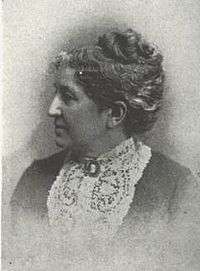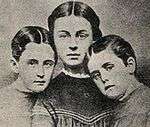Rebecca Sophia Clarke

Rebecca Sophia Clarke (February 22, 1833 – August 10, 1906),[1] also known as Sophie May, was an American author of children's fiction. Using her nieces and nephews as inspiration, she wrote realistic stories about children. She wrote 45 books between 1860 and 1903. The most popular being the Little Prudy books. She lived most of her life in her native town of Norridgewock, Maine, where she lived out her life with her sister, who was also a successful author.
Early life and education
Rebecca Sophia Clarke was born in Norridgewock, Maine, to Asa and Sophia Clarke on February 22, 1833. She was tutored at home in the classical languages of Greek and Latin and attended school at the Norridgewock Female Academy.[2] Along with her well rounded education, preparation for her role as a writer probably began with her diary, which she kept from ages nine to eleven, diligently recording the sermons, debates and lectures she attended.[3] At age 18, she moved to Evansville, Indiana, where she taught school. Her teaching career ended 10 years later due to a severe hearing loss and in 1861, she returned to her family home in Maine where she lived with her sister, Sarah Jones Clarke (1840-1929), who also wrote children's books and used the pen name, Penn Shirley.[4]
Career

Clarke's work was published using the pseudonym, "Sophie May". She penned that name in 1861 and used it to sign her first story, which was published in the Memphis Appeal. When the story was finished, she signed her name, Sophie, and then said: "Well, I'll call it May, for I may write again and I may not".[5]
Clarke was called "the Dickens of the nursery".[6] The children in her books were often naughty and uninhibited. She was one of the first authors to write stories for children that depicted them realistically with all their humor, imagination and mischievousness, unlike the impossibly perfect children of previous fiction. Her most successful stories were of the Little Prudy characters which made their first appearance in short stories for children's periodicals, such as Grace Greenewood's The Little Pilgrim and the Congregationalist.[7] Clarke's nieces were the inspiration for her characters; Prudy, Susy, and Dotty Dimple.[8] The series was later published into books.[4] She also contributed to other children's magazines, including Merry's Museum. From 1861 until 1903, Clarke wrote forty-five books, thirty-seven of these were series books and at least five of the others were also for children.

Later years
Clarke gave the city of Norridgewock a "brick building at the end of the bridge, to be used for library purposes and as a home for the "Village Improvement Society" in Norridgewock".[9] She traveled and spent her winters in Baltimore, Florida, as well as California.[2] After several months of "feeble health", Clarke died in Norridgewock, at the age of 73, on August 16, 1906.[6] She is buried at the Old Oak Cemetery.[8] Her longtime home in Norridgewock is listed on the National Register of Historic Places.
List of works
- Little Prudy (series 1864-1868)
- Little Prudy (1864), Sister Suzy (1864), Captain Horace (1864), Cousin Grace (1865), Fairy Book (1865), Dotty Dimple (1868)
- Dotty Dimple (series 1868-1869)
- Dotty Dimple at Her Grandmother's (1868), Dotty Dimple Out West (1868), Dotty Dimple at Home (1868), Dotty Dimple at Play (1869), Dotty Dimple at School (1869), Dotty Dimple's Flyaway (1869)
- Little Prudy's Flyaway (series 1870-1873)
- Little Folks Astray (1870), Prudy Keeping House (1870), Aunt Madge's Story (1871), Little Grandmother (1872), Little Grandfather (1873), Miss Thistledown (1873)
- Flaxie Frizzle(series 1876-1884)
- Flaxie Frizzle (1876), Doctor Papa (1877), Little Pitchers (1878), Twin Cousins (1880), Flaxie's Kittyleen (1883), Flaxie Growing Up (1884)
- Little Prudy's Children (series 1894-1901)
- Wee Lucy (1894), Jimmy Boy (1895), Kyzie Dunlee (1895), Wee Lucy's Secret (1899), Jimmy, Lucy, and All (1900), Lucy in Fairyland (1901)
- Quinnebasset Girls (series 1871-1903)
- Doctor's Daughter (1871), Our Helen (1874), Asbury Twins (1875), Quinebasset Girls (1877), Janet (1882), In Old Quinnebasset (1891), Joy Bells (1903)
- Other known books
- Drones' Honey (1887),
- Pauline Wyman (1897)
- The Champion's Diamonds (1897)
References
- ↑ "Rebecca Sophia Clarke." Almanac of Famous People. Gale, 2011. Biography In Context. Web. 28 Feb. 2013.
- 1 2 "Sophie May's Biography". Rebecca Sophia Clarke (1833-1906). Retrieved June 11, 2008.
- ↑ Kensinger, Faye Riter (1987). Children of the Series and how They Grew. Bowling Green, OH: Bowling Green State University Popular Press. p. 48. ISBN 0-87972-376-9.
- 1 2 "Nineteenth-Century American Children & What They Read". 19th-Century Girls' Series. Retrieved February 5, 2008.
- ↑ Willard, Frances E.; Livermore, Mary A. (1893). A Woman of the Century: Fourteen Hundred-Seventy Biographical Sketches Accompanied by Portraits of Leading American Women in All Walks of Life. Buffalo, NY: Charles Wells Moulton. p. 178. ISBN 0-87968-183-7.
- 1 2 "New York Times Archives" (PDF). Rebecca S. Clarke, (Sophia May.) August 18, 1906. August 18, 1906. Retrieved June 16, 2008.
- ↑ "Novel Guide". Rebecca Sophia Clarke. Retrieved February 5, 2008.
- 1 2 "Brandon University". The Edgar Rice Burroughs Library. Archived from the original on June 4, 2012. Retrieved June 9, 2008.
- ↑ Maine Dept. of Agriculture, (1904). Agriculture of Maine: ... Annual Report of the Commissioner of Agriculture. Kennebek Journal Print: Augusta. p. 102.
Further reading
- Maine League of Historical Societies and Museums (1970). Doris A. Isaacson, ed. Maine: A Guide 'Down East'. Rockland, Me: Courier-Gazette, Inc. p. 359.
External links
- Biography from readseries.com
- Works by Sophie May at Project Gutenberg
- Works by or about Sophie May at Internet Archive
- Works by or about Rebecca Sophia Clarke at Internet Archive
- Works by Rebecca Sophia Clarke at LibriVox (public domain audiobooks)
